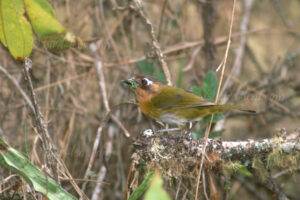 A Common Bush-Tanager (Chlorospingus flavopectus) of the subspecies fulvigularis of southern Bolivia has built a nest in a clay quarry along a shady forest trail. 4 hungry beaks are fed intensively in the Yungas of Bolivia near Remates.
A Common Bush-Tanager (Chlorospingus flavopectus) of the subspecies fulvigularis of southern Bolivia has built a nest in a clay quarry along a shady forest trail. 4 hungry beaks are fed intensively in the Yungas of Bolivia near Remates.
I had already found the nest yesterday during an afternoon stalk. I now decide to set up my hide, a camouflage tent, in front of the Common Bush-Tanager’s nest. After that is done, I am free and enjoy a lunch of potatoes, carrots and a spicy tomato sauce. After a nap, it’s the Common Bush-Tanager’s turn. I set up my Nikon Nikkor 600mm f/4D AF-I ED-IF with the Metz-Flashlight MZ-5 and wait for action at the nest. When my car arrived, I saw a bird fly away – so the nest is still occupied. After about 1 hour of patient waiting, both parents arrive to bring food and take droppings away. But this happens so fast that I am worried if I have anything at all on it. The flash is probably quite sufficient. The flash control showed ok at ASA 40 and f-stop 5.6. After another 30 minutes the mother comes and lets herself finally be photographed on a perch. I am happy. The young of the Common Bush-Tanager react to the song of the Common Bush-Tanager with blocking, the adults not at all. The arrival of the parents is announced by high and fine wispered calls. That and the moving the few twigs that are near the nest are usually enough to get trigger-prepared. Otherwise, however, there is little time.to focus. One good thing is that the Common Bush-Tanager parents always use a small twig as an approaching guard. I use that to focus on this branch. Later, however, I switch to autofocus, which also works quite well. This is especially true when the mother bird sits on the nest and the father comes with food. Then the male Bush-Tanager is a bit perplexed where to fly to and lets himself be photographed standing still for a moment in his perplexity.
The Common Bush Tanager has undergone many taxonomic changes in recent times. Around 2000 the species was still called Chlorospingus ophthalmicus and is now called Chlorospingus flavopectus – in this case with the subspecies fulvigularis – here in southern Bolivia. The english name has changed to Common Chlorospingus.
I could photograph the Common Chlorospingus and many other great birds 2 decades ago in Bolivia in a mountain nest called “Remates” (17°53’S, 64°21`W). Here you are (still?) in the Provincia Caballero and still in the Departamento of Santa Cruz. I don’t know if this area belongs to the Parque Nacional Carrasco or to the Parque Nacional Amboró or in between. But it doesn’t matter. The view is dreamlike in spite of the “only” 2000m. Like the whole mountain range, the mountain environment is characterized by perhumid high mountain forests and cloud forests. The annual precipitation in the region is between 3000 and 8000 mm, the annual average temperatures are between 12° and 15°C, but in areas above 2200 m a.s.l. they can drop down to 0°C in single nights in June/July. The whole mountain range is characterized by very steep slopes and the presence of many fast-flowing rivers. Natural landslides are frequent and result in a mosaic of forest formations in various stages of succession. Vegetation consists of mid-elevation evergreen montane forest with a large diversity of epiphytic bromeliads (e.g., Tillandsia, Guzmania), tree ferns (e.g., Cyathea, Nephelea), and bamboos (e.g., Chusquea). Human disturbance appears to be (still) limited to valley sites.
In humid climates, more precipitation falls than is used up by evaporation, full-humid climates have humid conditions year-round, and full-humid climates with high precipitation surpluses are called perhumid climates. So it’s always nice and humid up here.
Bird-lens is primarily a website designed to meet the growing demand for high-quality photographs of the birds of the Western Palearctic. In order to satisfy the demand for top-quality photographs of rare bird species, Bird-Lens.com has also made targeted trips to distant places such as Asia, Africa and the Americas. All this in order to be able to take excellent photos of birds. The yield of pictures not only of rare Western Palearctic birds is very good. The beautiful action image of the blog is only a first impression, what you can find in behind the tab “Picture Shop” very soon. Just leave a message if bird-lens.com can serve with a picture.